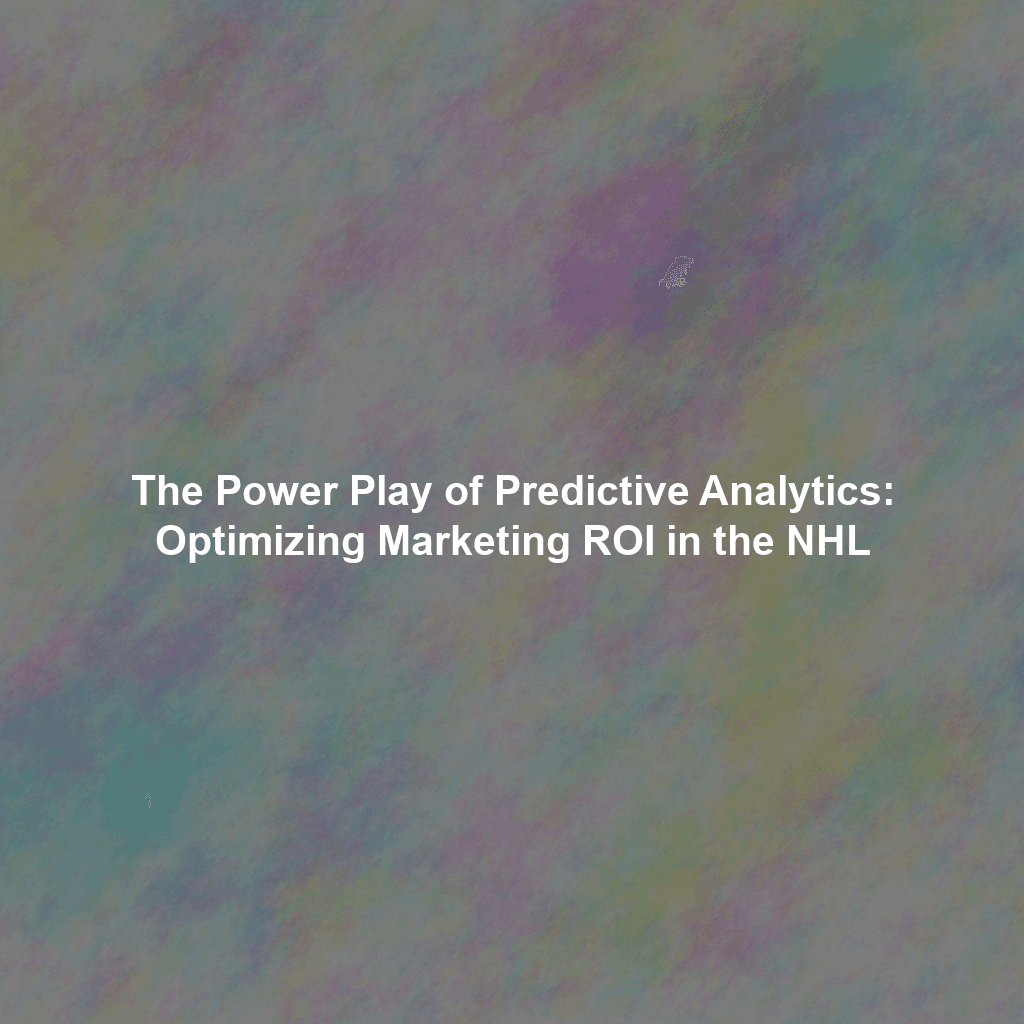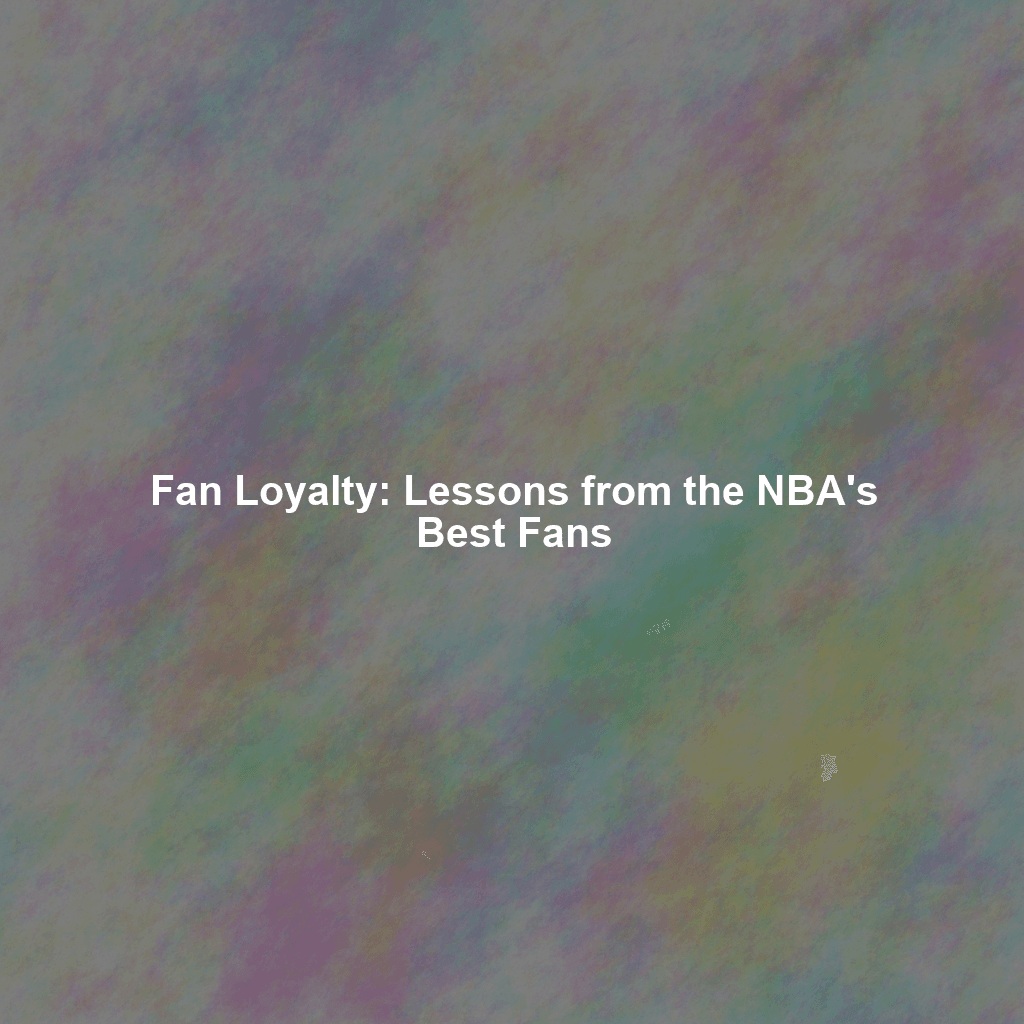Understanding Predictive Analytics in NHL Marketing
Predictive analytics uses statistical techniques, machine learning algorithms, and historical data to forecast future outcomes. In the context of NHL marketing, this means analyzing fan behavior, ticket sales, merchandise purchases, social media engagement, and a plethora of other data points to predict future trends and optimize marketing strategies.
Unlike traditional marketing methods that rely on intuition and guesswork, predictive analytics provides concrete, data-backed insights that empower NHL teams to make more informed decisions. This leads to more effective campaigns, increased fan engagement, and a stronger return on investment (ROI).
The Key Benefits of Predictive Analytics for NHL Teams:
- Enhanced Fan Engagement: Personalize the fan experience with targeted offers, content, and interactions.
- Optimized Ticket Pricing: Implement dynamic pricing strategies that maximize revenue based on demand.
- Effective Advertising Campaigns: Target the right fans with the right messages on the right channels.
- Improved Merchandise Sales: Forecast demand for specific merchandise items and optimize inventory management.
- Increased Sponsorship Value: Demonstrate the value of sponsorships by quantifying the reach and impact of marketing campaigns.
Personalizing the Fan Experience with Data-Driven Insights
In today’s digital age, fans expect personalized experiences. Predictive analytics allows NHL teams to deliver just that, by understanding individual fan preferences and tailoring interactions accordingly. This goes beyond simply knowing a fan’s favorite team; it delves into their purchasing habits, content consumption, and engagement patterns.
How to Personalize the Fan Experience:
- Segment Fans Based on Behavior: Identify different fan segments based on their purchasing history, attendance records, social media activity, and website interactions. For example, create segments for “season ticket holders,” “casual fans,” “online shoppers,” and “social media enthusiasts.”
- Targeted Email Marketing: Send personalized email campaigns to each segment, offering relevant content, promotions, and ticket deals. A casual fan might receive an offer for a discounted ticket package, while a season ticket holder might receive exclusive access to team events.
- Personalized Website Content: Customize the team’s website content based on a fan’s browsing history and preferences. Showcase articles and videos related to their favorite players, highlight upcoming games that align with their schedule, and recommend merchandise that matches their taste.
- Tailored Mobile App Experience: Use the team’s mobile app to deliver personalized notifications, game updates, and special offers. Send reminders about upcoming games, provide real-time stats and highlights, and offer discounts on concessions based on a fan’s location within the arena.
Example: The Tampa Bay Lightning uses data analytics to understand fan preferences and personalize their marketing efforts. By tracking ticket purchase history, online activity, and social media engagement, they can tailor email campaigns and website content to individual fans, resulting in higher engagement rates and increased ticket sales. They might offer a discount on Lightning gear to a fan who frequently visits the team store section of their website, or send a special invitation to a meet-and-greet with a player to a season ticket holder who is particularly active on social media.
Optimizing Ticket Pricing for Maximum Revenue
Selling tickets is the lifeblood of any NHL team. Predictive analytics can help optimize ticket pricing by forecasting demand and adjusting prices accordingly. This allows teams to maximize revenue while ensuring that games are well-attended.
Dynamic Ticket Pricing Strategies:
- Demand Forecasting: Use historical data, such as past attendance records, opponent strength, day of the week, and weather conditions, to predict demand for upcoming games.
- Algorithm-Based Pricing: Implement a dynamic pricing algorithm that automatically adjusts ticket prices based on real-time demand. Prices increase as demand rises and decrease as demand falls.
- Segment-Specific Pricing: Offer different ticket prices to different fan segments. For example, offer discounts to students, seniors, or military personnel.
- Package Deals: Create ticket packages that bundle together multiple games or include additional perks, such as concessions or merchandise discounts. This can attract fans who might not otherwise purchase individual tickets.
Example: Many NHL teams utilize Ticketmaster’s dynamic pricing tools, which leverage algorithms and real-time data to adjust ticket prices based on demand. A highly anticipated game against a rival team on a Saturday night will command higher prices than a mid-week game against a less popular opponent. This strategy allows teams to capture more revenue from high-demand games while filling seats for games that might otherwise have lower attendance.
Important Note: Transparency is key. Clearly communicate the pricing strategy to fans to avoid resentment or accusations of price gouging. Explain that prices fluctuate based on demand and that fans can often find better deals by purchasing tickets in advance or attending games on less popular nights.
Targeting Advertising Campaigns for Higher Conversion Rates
Reaching the right fans with the right message is crucial for effective advertising. Predictive analytics enables NHL teams to target their advertising campaigns with laser-like precision, ensuring that marketing dollars are spent wisely and generate a high return.
Strategies for Targeted Advertising:
- Audience Segmentation: Create detailed audience segments based on demographics, interests, online behavior, and purchasing history.
- Platform Optimization: Identify the most effective advertising platforms for reaching each segment. For example, younger fans might be more responsive to social media ads, while older fans might prefer traditional channels like television or radio.
- Personalized Ad Creative: Develop ad creative that resonates with each segment. Use language, imagery, and messaging that is tailored to their specific interests and needs.
- A/B Testing: Experiment with different ad variations to determine which ones are most effective. Test different headlines, images, and calls to action to optimize campaign performance.
Example: An NHL team might use Facebook Ads Manager to target fans who have expressed interest in hockey, live in the local area, and have purchased merchandise from the team’s online store. The ad could feature a special offer on a new jersey or a discount on tickets to an upcoming game. By targeting this specific audience, the team is more likely to generate clicks, leads, and sales.
Actionable Insight: Leverage lookalike audiences on platforms like Facebook and Google Ads. These tools allow you to find new potential customers who share similar characteristics with your existing fans, expanding your reach and improving campaign effectiveness.
Forecasting Merchandise Sales and Optimizing Inventory
Accurately forecasting merchandise sales is essential for managing inventory effectively and avoiding stockouts or excess inventory. Predictive analytics can help NHL teams anticipate demand for specific merchandise items, ensuring that they have the right products in stock at the right time.
Techniques for Merchandise Forecasting:
- Historical Sales Data: Analyze past sales data to identify trends and patterns in demand. Consider factors such as seasonality, player popularity, and team performance.
- Social Media Sentiment Analysis: Monitor social media conversations to gauge fan interest in specific merchandise items. Track mentions of players, jersey designs, and other relevant topics.
- External Factors: Take into account external factors that could influence demand, such as economic conditions, fashion trends, and celebrity endorsements.
- Machine Learning Models: Use machine learning algorithms to predict future sales based on a combination of historical data, social media sentiment, and external factors.
Example: If an NHL team signs a highly touted rookie player, predictive analytics can help forecast the demand for jerseys with that player’s name and number. By analyzing social media mentions, online searches, and pre-order data, the team can estimate the number of jerseys they need to produce to meet demand. This prevents stockouts and ensures that fans can purchase the merchandise they want.
Tool Recommendation: Consider using inventory management software with built-in forecasting capabilities. These tools can automate the forecasting process and provide valuable insights into inventory trends.
Analytical Techniques and Tools for NHL Marketing
A variety of analytical techniques and tools can be used in NHL marketing to extract insights from data. The choice of tools depends on the specific needs and resources of each team. Here are some common options:
Analytical Techniques:
- Regression Analysis: Used to identify the relationship between variables, such as ticket prices and attendance.
- Clustering: Used to segment fans into groups based on shared characteristics.
- Time Series Analysis: Used to forecast future trends based on historical data, such as ticket sales or merchandise demand.
- Sentiment Analysis: Used to gauge public opinion about the team, players, or marketing campaigns by analyzing social media posts and online reviews.
- Machine Learning Algorithms: Used for more complex predictive modeling tasks, such as demand forecasting or churn prediction (identifying fans who are likely to stop purchasing tickets or merchandise).
Analytical Tools:
- Google Analytics: A free web analytics tool that provides insights into website traffic, user behavior, and campaign performance.
- Tableau: A data visualization tool that allows users to create interactive dashboards and reports.
- Power BI: Another popular data visualization tool that offers similar functionality to Tableau.
- R and Python: Programming languages commonly used for statistical analysis and machine learning.
- CRM Systems (e.g., Salesforce, Microsoft Dynamics 365): Customer relationship management systems that store and manage fan data, enabling personalized marketing efforts.
Considerations: When selecting analytical tools, consider the following factors: ease of use, functionality, cost, and integration with existing systems. Start with simpler tools like Google Analytics and Tableau and gradually move to more advanced tools as your data analytics capabilities grow.
Data Privacy and Ethical Considerations
While predictive analytics offers tremendous potential, it’s crucial to address data privacy and ethical considerations. NHL teams must be transparent about how they collect and use fan data, and they must obtain consent before collecting sensitive information.
Key Principles for Ethical Data Use:
- Transparency: Clearly communicate your data collection and usage practices to fans.
- Consent: Obtain explicit consent before collecting sensitive information, such as location data or financial information.
- Data Security: Implement robust security measures to protect fan data from unauthorized access or breaches.
- Data Minimization: Collect only the data that is necessary for your marketing purposes.
- Fairness: Avoid using data in ways that could discriminate against certain fan segments.
- Compliance: Comply with all applicable data privacy regulations, such as GDPR (General Data Protection Regulation) and CCPA (California Consumer Privacy Act).
Best Practice: Develop a comprehensive data privacy policy that outlines your data collection, usage, and security practices. Make this policy easily accessible to fans on your website and in your mobile app.
Partner with Experts: If your team lacks in-house expertise in data privacy and compliance, consider partnering with a reputable data privacy consulting firm.
NHL Teams Successfully Using Predictive Analytics
Several NHL teams are already leveraging the power of predictive analytics to improve their marketing ROI. While specific details are often confidential, some examples highlight the possibilities:
- Tampa Bay Lightning: (Mentioned earlier) Known for their data-driven approach to personalizing the fan experience. They are recognized within the league for their effective use of data for marketing purposes.
- Los Angeles Kings: The Kings have invested heavily in data analytics to optimize ticket sales, improve fan engagement, and enhance sponsorship value. They use data to understand fan demographics, purchasing habits, and online behavior.
- Other Teams (anonymized examples): Many other teams are exploring and implementing predictive analytics in areas like dynamic ticket pricing, targeted advertising, and merchandise forecasting. These initiatives often remain proprietary to maintain a competitive advantage.
Key Takeaway: The successful adoption of predictive analytics requires a commitment from team leadership, investment in the necessary tools and expertise, and a willingness to experiment and iterate. It’s not a one-time project but an ongoing process of data collection, analysis, and optimization.
Ready to Take Your NHL Marketing to the Next Level?
Predictive analytics offers a powerful way to optimize your NHL marketing efforts and drive meaningful business outcomes. By leveraging data-driven insights, you can personalize the fan experience, optimize ticket pricing, target advertising campaigns, and forecast merchandise sales.
Conclusion
Predictive analytics is no longer a futuristic concept; it’s a present-day reality that is transforming the NHL marketing landscape. By embracing data-driven decision-making, NHL teams can enhance fan engagement, optimize revenue streams, and build stronger relationships with their fanbase. As the technology continues to evolve, the power of predictive analytics will only grow, making it an essential tool for any NHL team that wants to stay ahead of the game.
 Skip to content
Skip to content

